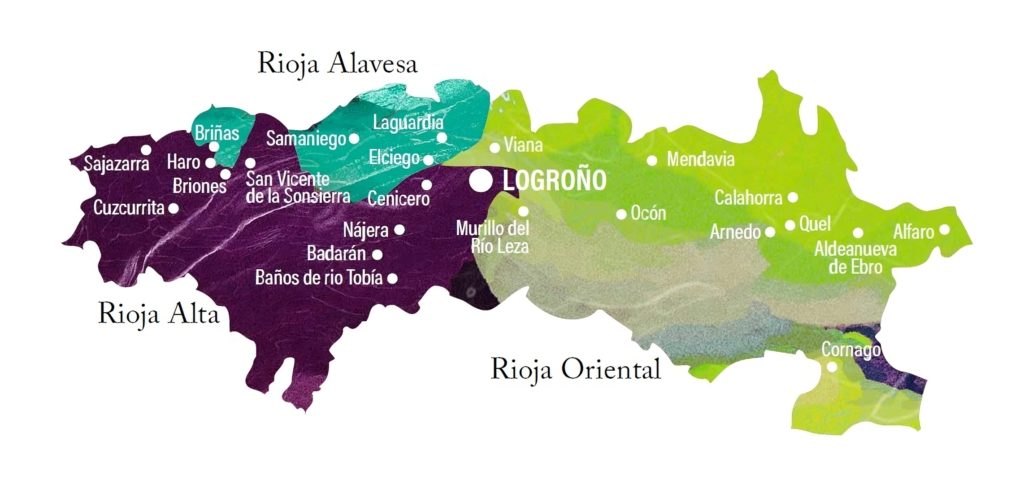The 66.000 hectares that make up the DOCa Rioja have three designated production zones within the appellation, each with specific characteristics. In addition, Rioja recognizes single zone and single village wines as well as singular vineyards meeting strict quality criteria. Within each zone there are certain areas that are not officially recognized but are coveted by wineries for the special characteristics of the grapes produced there.
The three officially recognized zones are Rioja Alta, Rioja Alavesa and Rioja Oriental.

Rioja Alta
Rioja Alta is the westernmost zone, located mainly on the south bank of the Ebro river, with a small area north of the river. Most of the century-old wineries are located here, notably in the Haro Train Station District.
77 towns and 27.871 hectares of vineyards make up the area.
The climatic influence is mainly Atlantic with winds blowing down the Ebro valley from the west. The temperature varies from -4C to +22C.
Rioja Alta contains a mosaic of soil types including clay and limestone, ferrous clay and alluvial.
There are several well-known grape growing areas within Rioja Alta. The upper Najerilla river valley is famous for producing garnacha grapes at altitude with high acidity, used in wineries to make white wine as well as base wines for DOCa Rioja sparkling wines. The area between Haro and Briones traditionally produces sought-after grapes for making wines suitable for long ageing.
Rioja Alavesa
Rioja Alavesa is located north of the Ebro, located exclusively within the province of Álava at the western end of the DOCa Rioja.
There are 18 towns and 13.178 hectares of vineyards here. The average temperature oscillates from -5º to +15ºC.
The vineyards are mainly south-facing and located on terraces sloping down to the river. The Sierra Cantabria acts as a barrier protecting the vineyards from the humidity and cold winds from the Bay of Biscay to the north.
The “Sonsierra” (beneath the Sierra de Cantabria) is a grape growing area in high demand shared by both Rioja Alta and Rioja Alavesa.
Rioja Oriental
This is the largest zone within the DOCa Rioja, with 25.191 hectares of vineyards. Here there are 49 towns with 92 wineries. The soil types are predominantly ferrous clay and alluvial.
Rioja Oriental is the easternmost zone, located mainly on the south bank of the Ebro. Here the valley widens, allowing for large plots of vines on the plains near the river. One of the most sought-after areas here is on the south-facing slopes of Mount Yerga, the highest elevation within the Rioja appellation.
Here, the climate is predominantly Mediterranean, with warm winds blowing from the mountains and from the east.
Traditionally, because of the warm temperatures there, Rioja Oriental was famous for the cultivation of garnacha grapes that were blended with tempranillo and other red varieties. Most garnacha was replaced with tempranillo throughout the 1980s and 90s but in recent years, garnacha has been replanted, especially on higher elevations.
Rioja is famous for its blends from the three zones
Rioja has been famous for its blends of grapes from the three zones. In the past, wines from the colder elevations of Rioja Alta and Alavesa were blended with wines from the Oriental to produce wines with 12 to 13% alcohol. Today, however, global warming has allowed the Alta and Alavesa grapes to ripen fully, with grapes reaching 14% to 14,5%.
The new trend towards more specific origin
Rioja regulations have been amended to reflect changing times and consumer trends. Now it is possible, subject to strict rules, to label wines according to the specific zone (Alta, Alavesa and Oriental), a village and even the vineyard where the grapes are produced. Today there are 162 singular vineyards (viñedos singulares) on 265 hectares.
Text by Tom Perry, Inside Rioja
Photos: Qualified Designation of Origin Rioja’s Control Board
Learn more about Bilbao-Rioja Great Wine Capitals